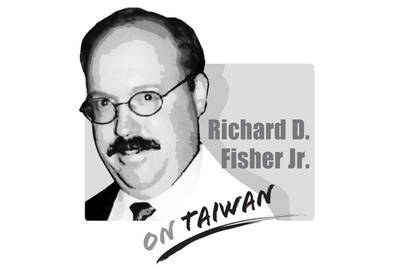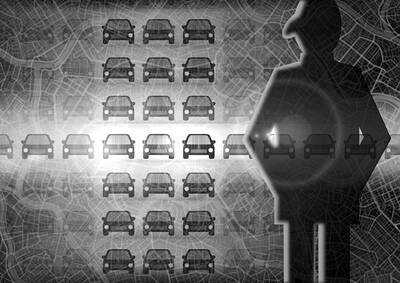Ever since the government proposed that Taiwan be transformed into a bilingual nation by 2030, people have been debating the policy’s pros and cons. Experts and academics have offered various theoretical arguments, but one standard answer has not surfaced. In my view, as a teacher, achieving the policy requires a review of the issues from a practical perspective, from the viewpoint of Taiwan’s educational structure and characteristics.
The education system is dominated by test-oriented learning. Most regular teachers view bilingual instruction as extra work, while teachers of subjects tested in the joint entrance exams even view it as a threat.
The paradox of bilingual education lies in the incompatibility between the new policy and the classroom situation. Schools have long emphasized academic performance for the sake of being accepted to the next tier of education. To guard the academic reputation of schools and have graduates accepted to their preferred universities, students are trained to strive for high test scores. Test-taking skills are the focus of this educational environment.
For example, with this test-oriented instruction, most students learn English just to pass English listening, reading and writing tests. As spoken English is not included in the joint entrance exams, students generally do not practice speaking it.
As a result, in real-life situations — such as watching English-language movies, listening to English-language radio stations or interacting with foreigners, students find it difficult to translate what they have learned in class into actual conversation.
Students might be good test takers, but that does not mean that they know how to apply the language. This is especially true in Taiwan’s education system.
This situation makes implementing the bilingual policy difficult, because it is not taken into consideration by the Comprehensive Assessment Program for Junior High School Students, or by the General Scholastic Ability Test and Advanced Subjects Test for senior-high school students. For example, all of the questions in these exams are in Chinese.
Teachers, who are the executors of the will of the state, have long been conditioned by these exams. The authorities’ will might satisfy parents’ fantasies about bilingual education, but they are overlooking teachers’ hard work in the classroom as they add additional education measures.
What about the children? Due to the country’s long-standing “credentialist” approach, they continue to take the same tests in new forms, generation after generation.
The government’s bilingual policy and Taiwan’s test-oriented education system clash with each other. Unless half of the questions are given in English on exams, it will be difficult to promote bilingual education in tested subjects.
On the other hand, many schools have started the bilingual teaching of non-tested subjects. For example, elementary and junior-high schools in Taipei are recruiting a large number of bilingual teachers this year for non-academic subjects not tested in the exams.
This highlights how inconsistent the education system is, and the lack of equivalence between subjects. One could hope that the bilingual policy will be more pragmatic, and that top decisionmakers will be more idealistic and down-to-earth.
To create a solution that benefits everyone, the authorities should visit schools and listen to what teachers have to say. Bilingual education needs a balance between the goal and the actual, detailed implementation.
Tao Yi-che is a teacher at Affiliated High School of National Chengchi University.
Translated by Eddy Chang
Concerns that the US might abandon Taiwan are often overstated. While US President Donald Trump’s handling of Ukraine raised unease in Taiwan, it is crucial to recognize that Taiwan is not Ukraine. Under Trump, the US views Ukraine largely as a European problem, whereas the Indo-Pacific region remains its primary geopolitical focus. Taipei holds immense strategic value for Washington and is unlikely to be treated as a bargaining chip in US-China relations. Trump’s vision of “making America great again” would be directly undermined by any move to abandon Taiwan. Despite the rhetoric of “America First,” the Trump administration understands the necessity of

US President Donald Trump’s challenge to domestic American economic-political priorities, and abroad to the global balance of power, are not a threat to the security of Taiwan. Trump’s success can go far to contain the real threat — the Chinese Communist Party’s (CCP) surge to hegemony — while offering expanded defensive opportunities for Taiwan. In a stunning affirmation of the CCP policy of “forceful reunification,” an obscene euphemism for the invasion of Taiwan and the destruction of its democracy, on March 13, 2024, the People’s Liberation Army’s (PLA) used Chinese social media platforms to show the first-time linkage of three new

If you had a vision of the future where China did not dominate the global car industry, you can kiss those dreams goodbye. That is because US President Donald Trump’s promised 25 percent tariff on auto imports takes an ax to the only bits of the emerging electric vehicle (EV) supply chain that are not already dominated by Beijing. The biggest losers when the levies take effect this week would be Japan and South Korea. They account for one-third of the cars imported into the US, and as much as two-thirds of those imported from outside North America. (Mexico and Canada, while
I have heard people equate the government’s stance on resisting forced unification with China or the conditional reinstatement of the military court system with the rise of the Nazis before World War II. The comparison is absurd. There is no meaningful parallel between the government and Nazi Germany, nor does such a mindset exist within the general public in Taiwan. It is important to remember that the German public bore some responsibility for the horrors of the Holocaust. Post-World War II Germany’s transitional justice efforts were rooted in a national reckoning and introspection. Many Jews were sent to concentration camps not